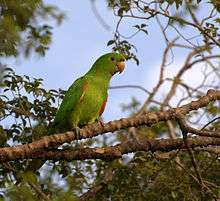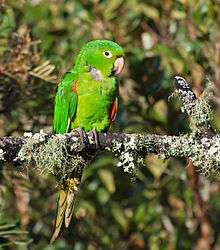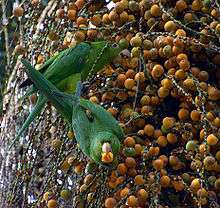White-eyed parakeet
The white-eyed parakeet or white-eyed conure (Psittacara leucophthalmus) is a small green Neotropical parrot native to South America.
| White-eyed parakeet | |
|---|---|
 | |
| In Piraju, Brazil | |
| Scientific classification | |
| Kingdom: | Animalia |
| Phylum: | Chordata |
| Class: | Aves |
| Order: | Psittaciformes |
| Family: | Psittacidae |
| Genus: | Psittacara |
| Species: | P. leucophthalmus |
| Binomial name | |
| Psittacara leucophthalmus (Statius Muller, 1776) | |
| Synonyms[2] | |
|
Aratinga leucophthalma | |
Taxonomy
First described by German zoologist Philipp Ludwig Statius Müller in 1776, its specific epithet is derived from the Ancient Greek leukos "white" and ophthalmos "eye".[3]
Dickinson (2003) recognised three subspecies: Aratinga leucophthalma nicefori, A. l. callogenys and A. l. leucophthalma.
Description


The white-eyed parakeet measures 30–34 cm (12–13 in) in length and 37–40 cm (15–16 in) in wingspan, with a body mass of 100–218 g (3.5–7.7 oz).[4][5] is an overall green bird with red on the shoulders and some random flecks of red on the head and neck. The underwing primary coverts are red tipped yellow. A prominent white eye ring gives this species its name. In addition to the nominate, there are two very similar subspecies, callogenys and nicefori, although the validity of the latter, based on a single specimen, is questionable. Juveniles have little or no red and yellow in their plumage.
Distribution and habitat
White-eyed parakeets are found over much of northern South America, including Trinidad in the caribbean, from eastern Venezuela, Colombia and the Guianas in the north across Brazil to northern Argentina and Uruguay in forests, woodland, savanna and mangroves.[6][7] Adapts readily to degraded and urban areas, provided there are sources of food and nesting places (under roofs and other cavities) and occurs in several cities.
Conservation status
The species is listed under CITES Appendix II. It is category least concern on IUCN Redlist. According to the IUCN, this bird has been heavily trafficked since 1981.
Aviculture
Though not as popular as some of the more colorful parakeets, the white-eyed parakeet can become a sweet, loving and talkative pet. They are seldom destructive and are generally not screamers, often choosing to mimic speech instead. Although many breeders ignore this species, those that do breed them appreciate their good parenting skills. Breeding requirements for white-eyed parakeets are much the same as for other parakeet species.
They will usually start to go to nest in March or April, sometimes breeding throughout the year and having four to six clutches. The clutch size is usually four eggs. Chicks will sometimes start to talk by the time they are weaned and generally will talk by six months of age.
White-eyed parakeets are sometimes confused with Finsch's parakeets because both have the red and yellow epaulets under their wings. The white-eyed parakeets lack the red triangle on the forehead as adults. In captivity they can live for nearly 28 years.
References
- BirdLife International (2012). "Psittacara leucophthalmus". IUCN Red List of Threatened Species. 2012. Retrieved 26 November 2013.CS1 maint: ref=harv (link)
- "Aratinga leucophthalmus". Avibase.
- Liddell, Henry George & Robert Scott (1980). A Greek-English Lexicon (Abridged Edition). United Kingdom: Oxford University Press. ISBN 0-19-910207-4.
- CRC Handbook of Avian Body Masses by John B. Dunning Jr. (Editor). CRC Press (1992), ISBN 978-0-8493-4258-5.
- "White-eyed Parakeet (Aratinga leucophthalma) » Planet of Birds".
- Forshaw, Joseph M. & Cooper, William T. (1978): Parrots of the World (2nd ed). Landsdowne Editions, Melbourne Australia ISBN 0-7018-0690-7
- Juniper, T., & M. Parr (1998). A Guide to the Parrots of the World. Pica Press, East Sussex. ISBN 1-873403-40-2
External links
| Wikimedia Commons has media related to Psittacara leucophthalmus. |
- White-eyed parakeet videos on the Internet Bird Collection
- Stamps (for French Guiana, Paraguay) with ~RangeMap
- "White-eyed parakeet (Aratinga leucophthalma) - BirdLife Species Factsheet". BirdLife International (2008). Retrieved 3 January 2009.
